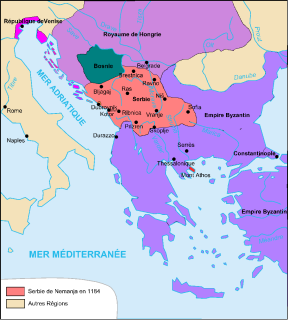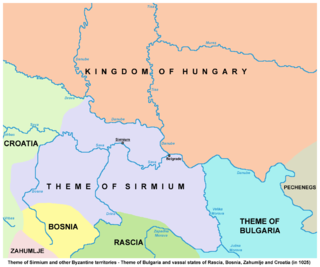 W
WSerbia in the Middle Ages refers to the medieval period in the history of Serbia. The period begins in the 6th century with the Slavic migrations to Southeastern Europe, and lasts until the Ottoman conquest of Serbian lands in the second half of the 15th century. The period is also extended to 1537, when Pavle Bakić, the last titular Despot of Serbia in Hungarian exile, fell in the Battle of Gorjani.
 W
WThe Middle Ages in the Banat started around 900. Around that time, Duke Glad ruled Banat, according to the Gesta Hungarorum. Archaeological finds and 10th-century sources evidence that Magyars settled in the lowlands in the early 10th century, but the survival of Avar, Slav and Bulgar communities can also be documented. A local chieftain, Ajtony, converted to Eastern Orthodoxy around 1000, but his attempts to control the delivery of salt on the Mureș River brought him into conflict with Stephen I of Hungary. Ajtony died fighting against the royal army in the first decades of the 11th century. His realm was transformed into a county of the Kingdom of Hungary. Counties were the most prominent units of royal administration.
 W
WThe Crnojević printing house or Cetinje printing house, was the first printing house in Southeastern Europe; the facility operated between 1493 and 1496 in Cetinje, Zeta.
 W
WIvan Crnojević, also known as Ivan the Black, was the lord of Zeta and Serbian leader. from 1465 to 1490. Having formed an uneasy alliance with the Republic of Venice, he led the resistance against the expanding Ottoman Empire. He was successful at first but lost his realm in 1479. He resumed power in 1481 and soon founded Cetinje as the new capital of his state.
 W
WThe Serbian Despotate was a medieval Serbian state in the first half of the 15th century. Although the Battle of Kosovo in 1389 is generally considered the end of medieval Serbia, the Despotate, a successor of the Serbian Empire and Moravian Serbia, lasted for another 60 years, experiencing a cultural and political renaissance before it was conquered by the Ottomans in 1459. Before its conquest the Despotate nominally had a suzerain status to the Ottoman Empire, Byzantine Empire and Kingdom of Hungary. After being fully subjugated to the Ottoman Empire in 1459, it continued to exist in exile in the medieval Kingdom of Hungary until the mid-16th century. Pavle Bakić was the last Despot of Serbia to be recognized by both the Ottoman and the Habsburg Monarchy.
 W
WStefan Uroš IV Dušan, known as Dušan the Mighty, was the King of Serbia from 8 September 1331 and Tsar and autocrat of the Serbs and Greeks from 16 April 1346 until his death. Dušan conquered a large part of southeast Europe, becoming one of the most powerful monarchs of the era. Under Dušan's rule, Serbia was the major power in the Balkans, and an Eastern Orthodox multi-ethnic and multi-lingual empire that stretched from the Danube in the north to the Gulf of Corynth in the south, with its capital in Skopje. He enacted the constitution of the Serbian Empire, known as Dušan's Code, perhaps the most important literary work of medieval Serbia.
 W
WDušan's Code is a compilation of several legal systems that was enacted by Stefan Uroš IV Dušan of Serbia in 1349. It was used in the Serbian Empire and the succeeding Serbian Despotate. It is considered an early constitution, or close to it; an advanced set of laws which regulated all aspects of life.
 W
WThe fall of the Serbian Empire was a decades-long process in the late 14th century. Following the death of childless Emperor Stefan Uroš V in 1371, the Empire was left without an heir and the magnates, velikaši, obtained the rule of its provinces and districts, continuing their offices as independent with titles such as gospodin, and despot, given to them during the Empire. This period is known as the dissolution or the beginning of the fall of the Serbian Empire.
 W
WThe Gepids were an East Germanic tribe who lived in the area of modern Romania, Hungary and Serbia, roughly between the Tisza, Sava and Carpathian mountains. They were closely related to, or a subdivision of, the Goths.
 W
WGrand Principality of Serbia was a medieval Serbian state that existed from the second half of the 11th century up to 1217, when it was transformed into the Kingdom of Serbia. Initially, the Grand Principality of Serbia emerged in the historical region of Raška, and gradually expanded, during the 12th century, encompassing various neighboring regions, including territories of modern Montenegro, Herzegovina, and southern Dalmatia. It was founded by Grand Prince Vukan, who initially served as regional governor of Raška, appointed by King Constantine Bodin. During Byzantine-Serbian wars Vukan gained prominence and became self-governing ruler in inner Serbian regions. He founded the Vukanović dynasty, that ruled the Grand Principality. Through diplomatic ties with the Kingdom of Hungary, Vukan′s successors managed to retain their self-governance, while also recognizing the supreeme overlordship of the Byzantine Empire, up to 1180. Grand Prince Stefan Nemanja (1166-1196) gained full independence and united almost all Serbian lands. His son, Grand Prince Stefan was crowned King of Serbia in 1217, while his younger son Saint Sava became the first Archbishop of Serbs, in 1219.
 W
WThe Kingdom of Hungary was a monarchy in Central Europe that existed from the Middle Ages into the 20th century. The Principality of Hungary emerged as a Christian kingdom upon the coronation of the first king Stephen I at Esztergom around the year 1000; his family led the monarchy for 300 years. By the 12th century, the kingdom became a European middle power within the Western world.
 W
WThe Medieval Monuments in Kosovo are a World Heritage Site consisting of four Serbian Orthodox Christian churches and monasteries which represent the fusion of the eastern Orthodox Byzantine and the western Romanesque ecclesiastical architecture to form the Palaiologian Renaissance style. The construction was founded by members of Nemanjić dynasty, the most important dynasty of Serbia in the Middle Ages. The sites are located in the modern-day Kosovo.
 W
WSerbian art refers to the visual arts of the Serbs and their nation-state Serbia. The medieval heritage includes Byzantine art, preserved in architecture, frescos and icons of the many Serbian Orthodox monasteries. In the Early modern period, Serbian visual arts began to be influenced by Western art, culminating in the Habsburg Monarchy in the late 18th century. The beginning of modern Serbian art is placed in the 19th century. Many Serbian monuments and works of art have been lost forever due to various wars and peacetime marginalizations.
 W
WMihailo Vojislavljević was the king of Dioclea (Duklja), from 1050 to 1081 initially as a Byzantine vassal holding the title of protospatharios, then after 1077 as nominally serving Pope Gregory VII, addressed as "King of the Slavs". He had alienated himself from the Byzantines when he supported a Byzantine Slavic revolt in 1071–72, after which he then sought to gain support in the West. In 1077 he received a royal insignia by Gregory VII in the aftermath of the Church schism of 1054.
 W
WMiroslav's Gospel is a 362-page Serbian illuminated manuscript Gospel Book on parchment with very rich decorations. It is one of the oldest surviving documents written in the Serbian recension of Church Slavonic. The gospel is considered a masterpiece of illustration and calligraphy.
 W
WMoravian Serbia or Realm of Prince Lazar is the name used in historiography for the largest and most powerful Serbian principality to emerge from the ruins of the Serbian Empire (1371). Moravian Serbia is named after Morava, the main river of the region. Independent principality in the region of Morava was established in 1371, and attained its largest extent in 1379 through the military and political activities of its first ruler, prince Lazar Hrebeljanović. In 1402 it was raised to the Serbian Despotate, which would exist until 1459.
 W
WOld Serbia is a term in Serbian historiographical discourse that is used to describe the territory that according to the dominant school of Serbian historiography in the late 19th century formed the core of the Serbian Empire in 1346-71.
 W
WThe Peć–Mitrovica road (Пећ—Митровица) or Mitrovica–Peć road (Митровица—Пећ) was a road of Serbia in the Middle Ages, an extension of the Ibar road. It was used exclusively for caravans. It was reconstructed by the Ottoman authorities prior to the Balkan Wars but due to insecurity it was abandoned. The Serbian government continued the reconstruction mostly after 1919 and in 1925 it became part of the 650 km long Belgrade–Kotor road. It was further reconstructed in 1928.
 W
WRaška is a geographical and historical region, covering the south-western parts of modern Serbia, and historically also including north-eastern parts of modern Montenegro, and some of the most eastern parts of modern Bosnia and Herzegovina. In the Middle Ages, the region was a center of the Serbian Principality and of the Serbian Kingdom, one central settlement of which was the city of Ras in the late 12th century. Its southern part corresponds to the region of Sandžak.
 W
WThe Realm of Stefan Dragutin was a medieval Serb kingdom. Initially, it was a vassal kingdom of the Kingdom of Hungary, but subsequently became an independent kingdom, after the collapse of the central power in the Kingdom of Hungary. It was ruled by the Serbian kings Stefan Dragutin (1282–1316) and his son Stefan Vladislav II (1316–1325). The kingdom was centered in the region of Lower Syrmia and its first capital was Debrc, while residence of the king was later moved to Belgrade.
 W
WDuchy of Saint Sava was a late medieval Serbian state which existed amid the Ottoman conquest of the Balkans. It was ruled by Stjepan Vukčić and his son Vladislav, of the Kosača noble family, and included significant part of modern-day Bosnia and Herzegovina, and extended to parts of modern-day coastal Croatia, eastern Montenegro and southeastern corner of Serbia, also known as Sandžak. Stjepan titled himself "Herceg of Saint Sava", after the first Serbian Archbishop, Saint Sava. The title is of German origin, Herzog ("Duke"), and it was used as an equivalent to the Serbian term Vojvoda. Stjepan's title would later give the name to the present-day region of Herzegovina, as the Ottomans used Hersek Sancağı for the province which was transformed into an Ottoman sanjak.
 W
WṢaqāliba is a term used in medieval Arabic sources to refer to Slavs and other peoples of Central and Eastern Europe, or in a broad sense to European slaves. The term originates from the Middle Greek slavos/sklavenos (Slav), which in Hispano-Arabic came to designate first Slavic slaves and then, similarly to the semantic development of the term in other West-European languages, foreign slaves in general. The word is often misused to refer only to slaves from Central and Eastern Europe, but it refers to all Europeans and others traded by the Arab traders during the war or peace periods.
 W
WThe Kingdom of Serbia, or Serbian Kingdom, was a medieval Serbian state that existed from 1217 to 1346, ruled by the Nemanjić dynasty. The Grand Principality of Serbia was elevated with the regal coronation of Stefan Nemanjić as king, after the reunification of Serbian lands. In 1219, Serbian Orthodox Church was reorganized as an autocephalous archbishopric, headed by Saint Sava. The kingdom was proclaimed an empire in 1346, but kingship was not abolished as an institution, since the title of a king was used as an official designation for a co-ruler of the emperor.
 W
WOld Church Slavonic or Old Slavonic, also known as Old Church Slavic, or Old Slavic was the first Slavic literary language. It is also referred to as Paleo-Slavic (Paleoslavic) or Palaeo-Slavic (Palaeoslavic),, or sometimes as Old Bulgarian, Old Macedonian or Old Slovenian. It is often abbreviated to OCS.
 W
WThe Syrmia County was an administrative division of the Kingdom of Hungary in the Middle Ages. It was established in the 13th century, and included most of what is today Serbian Syrmia. It was subordinated to the Banate of Macsó. It was conquered by the Ottomans in 1526.
 W
WTepčija was a court title of Croatia, Serbia and Bosnia in the Middle Ages. The functions and position in the court is unclear. It was first mentioned in Croatia in the second half of the 11th century, and later in Serbia in the first half of the 13th century, and in Bosnia during 13th and 14th century. The title-holder took care of the country's feudal estates. There were two or three levels in title, the veliki tepčija (grand), "tepčija" and mali tepčija (lower). "Veliki tepčija" took care of the royal estates. Tepčija had a similar office to that of the kaznac, and cared of all major feudal estates bar that which belonged to the Court. "Tepčija" had executive authorities. His servants were called otroci.
 W
WThe Theme of Sirmium was a Byzantine administrative unit (theme), which existed in present-day Serbia, Croatia and Bosnia and Herzegovina in the 11th century. Its capital was Sirmium.
 W
WTravunija or Travunia, was a South Slavic medieval principality that was part of Medieval Serbia (850–1371), and later the Medieval Bosnia (1373–1482). The principality became hereditary in a number of noble houses, often kin to the ruling dynasty. The region came under Ottoman rule in 1482. Its seat was in the city of Trebinje.
 W
WVladislav was the King of Syrmia from 1316 to 1325, and claimant to the Serbian Kingdom.
 W
WThe Vojislavljević was a Serbian medieval dynasty, named after archon Stefan Vojislav, who wrested the polities of Duklja, Travunia, Zahumlje, inner Serbia and Bosnia from the Byzantines in the mid-11th century. His successors, kings Mihailo I Vojislavljević and Constantine Bodin expanded and consolidated the state. During the 12th century, the main line of the Vojislavljević family was ousted by their cadet branch, the Vukanović, in the late 12th century.
 W
WZachlumia or Zachumlia, also Hum, was a medieval principality located in the modern-day regions of Herzegovina and southern Dalmatia. In some periods it was a fully independent or semi-independent South Slavic principality. It maintained relations with various foreign and neighbouring powers and later was subjected to Kingdom of Hungary, Kingdom of Serbia, Kingdom of Bosnia, Duchy of Saint Sava and at the end to the Ottoman Empire.
 W
WZeta was one of the medieval polities that existed between 1356 and 1421, whose territory encompassed parts of present-day Montenegro and northern Albania, ruled by the Balšić family.
 W
WThe Crnojević noble family ruled the Zeta from 1451 until 1496. The state included parts of modern Montenegro and parts of modern Albania.
 W
WThe Principality of Serbia was one of the early medieval states of the Serbs, located in western regions of Southeastern Europe. It existed from the 8th century up to c. 969-971 and was ruled by the Vlastimirović dynasty. Its first ruler known by name was Višeslav who started ruling around 780. While by that time, starting from the year 680-681, the Bulgarian state had taken the lands to the east. Vlastimir defeated the Bulgarian army in a three-year-war (839–842), and the two powers lived in peace for some decades. Vlastimir's three sons succeeded in ruling Serbia together, although not for long; Serbia became a key part in the power struggle between the Byzantines and Bulgarians, predominantly allied with the Byzantines, which also resulted in major dynastic wars for a period of three decades. Central parts of the principality were shortly occupied by the Bulgarian army for three years (924–927), until Serbian prince Časlav was established as ruler of the Serbian land, unite several Serbian regions, becoming the most powerful ruler of the Vlastimirović dynasty. An important process during this period was the Christianization of the Serbs, the establishment of Christianity as state-religion c. 869, and the founding of the first Serbian eparchy (diocese), the Eparchy of Ras. The principality was annexed by the Byzantines in c. 969-971 and ruled as the Catepanate of Ras. The main information of the history of the principality and Vlastimirović dynasty are recorded in the contemporary historical work De Administrando Imperio.